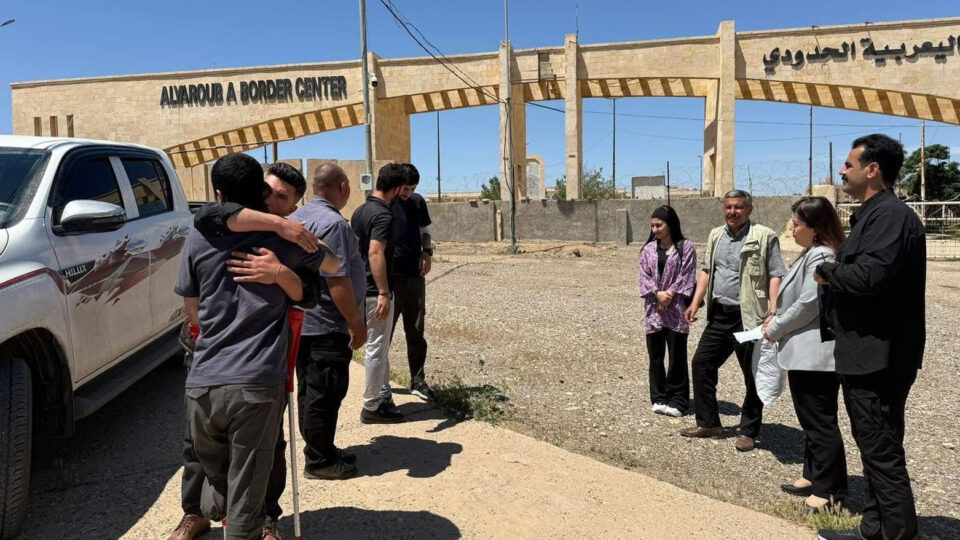Sema
The two young men, Diyar Ali Raffo, born in 2003 in the village of Kocho, and Othman Khilo Khadida, born in 2007 in the village of Wardiya, returned home after years of unimaginable hardship.
In a moment of relief amid ongoing suffering, two Yazidi youths were reunited with their families on Sunday through the Rabia border crossing after enduring more than a decade of brutal captivity under the so-called Islamic State (ISIS).
The two young men, Diyar Ali Raffo, born in 2003 in the village of Kocho, and Othman Khilo Khadida, born in 2007 in the village of Wardiya, returned home after years of unimaginable hardship.
During their captivity, they were subjected to harsh treatment and exploitation, with Diyar losing one of his eyes and Othman losing his right hand as a result of forced training and abuse at the hands of ISIS terrorists.
Their long-awaited return highlights both a moment of personal triumph and the broader, unresolved tragedy of the Yazidi community. Hundreds of Yazidi families continue to await news of loved ones still missing, underscoring the urgent humanitarian need to intensify rescue efforts and bring closure to a deeply painful chapter.
According to the Office for the Rescue of Abducted Yazidis, as of March 2, 2025, a total of 2,558 Yazidis remain missing, their fate unknown. These figures, corroborated by United Nations-accredited sources, paint a grim picture of the community’s ordeal. Before ISIS’s assault on August 3, 2014, Iraq’s Yazidi population numbered approximately 550,000. Today, 135,860 Yazidis remain displaced in camps across the Kurdistan Region, with another 189,337 scattered across various locations in the region.
The human cost of the genocide is staggering: over 5,000 Yazidis have been killed, and 2,745 children have been orphaned. To date, 93 mass graves have been discovered in Shingal (Sinjar) along with dozens of individual graves, yet only 29 individuals have been recorded among the survivors pulled from these sites.
ISIS’s campaign of destruction against Yazidi heritage was equally devastating. According to the same statistics, the terrorist group destroyed 68 Yazidi religious shrines and sanctuaries, a deliberate assault on the community’s spiritual and cultural identity. Meanwhile, approximately 120,000 Yazidis have emigrated abroad in search of safety and a new beginning.
The numbers further reveal that ISIS abducted 6,417 Yazidis, including 3,548 females and 2,869 males. Of those, 3,585 survivors have been rescued—1,211 women, 339 men, 1,074 girls, and 961 boys. The remains of 274 abductees, including 37 females and 237 males, have been recovered from mass graves and returned to their families.
Despite these ongoing efforts, the scale of the tragedy continues to cast a long shadow over the Yazidi community. As reported earlier by Kurdistan24, Yazidi survivors who return often face immense psychological and social challenges, underscoring the need for sustained rehabilitation programs. Many survivors, like the Yazidi woman recently rescued and returned to the Kurdistan Region, require extensive mental health support and reintegration assistance.
Further compounding the humanitarian crisis, thousands of Yazidis are still listed as missing, with little clarity regarding their fate. As highlighted by Kurdistan24’s previous reporting, while local and international organizations have worked tirelessly to rescue captives, the lack of a centralized and adequately funded recovery program remains a major obstacle.
Political factors have also slowed progress. The delayed implementation of the Sinjar Agreement, meant to restore stability and governance to the war-ravaged region, has been criticized for neglecting Yazidi needs, according to the Kurdistan Democratic Party (KDP) spokesperson Vian Dakhil’s remarks covered by Kurdistan24.
On International Women’s Day 2025, Kurdish lawmakers renewed their appeals to intensify efforts for Yazidi women survivors, who continue to endure the physical and emotional scars left by ISIS’s systematic campaign of gender-based violence.
As the international community marks each small victory in the effort to heal the wounds inflicted by ISIS, Yazidis continue to call for greater action—not only to rescue the missing but also to prosecute those responsible and rebuild the shattered heart of Yazidi society.
The return of Diyar and Othman stands as a powerful testament to resilience and hope, but it also serves as a solemn reminder that the struggle for justice, healing, and full liberation is far from over.

